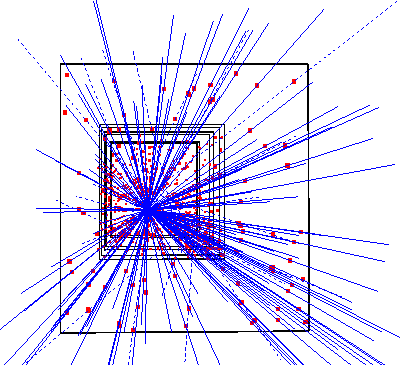In both experiments the main tracking device
was a set of silicon detectors (silicon telescope). In WA97
(1995 setup) it consisted of 7 planes of Omega2
pixel detectors and of 10 planes of silicon microstrips with a
![]() pitch.
In NA57 the silicon telescope consisted
only of Omega2 and Omega3
silicon pixel planes. This tracking device was placed in order to
accept particles at central
rapidity (
pitch.
In NA57 the silicon telescope consisted
only of Omega2 and Omega3
silicon pixel planes. This tracking device was placed in order to
accept particles at central
rapidity (![]() )
and medium transverse momentum (e.g. for
)
and medium transverse momentum (e.g. for
![]()
![]() ).
The apparatus was placed in a magnetic field (1.8 Tesla provided by
the Omega magnet for WA97 and 1.4 Tesla provided by the Goliath
magnet for NA57). In WA97 three MWPC's with a pad cathode readout
were used, as lever arm detectors, to improve the momentum resolution
of fast tracks, while NA57 used a set of double-sided microstrip
planes.
).
The apparatus was placed in a magnetic field (1.8 Tesla provided by
the Omega magnet for WA97 and 1.4 Tesla provided by the Goliath
magnet for NA57). In WA97 three MWPC's with a pad cathode readout
were used, as lever arm detectors, to improve the momentum resolution
of fast tracks, while NA57 used a set of double-sided microstrip
planes.
In both experiments the Pb+Pb events were triggered by a set of scintillators ("petals") which provided a fast estimation of the charged particle multiplicity. The microstrip multiplicity detectors (MSD) provided a more precise estimate of the event multiplicity to be used in the offline analysis of the centrality.
|
WA97 perspective view. |
WA97 top view. |
|
NA57 layout. |
In WA97 and NA57 the track reconstruction in
a high multiplicity environment relies mostly on the new technology
of the silicon pixels developed by the CERN Microelectronics
group (RD19 collaboration). This technique was applied in the
construction of two generations of chips: the Omega2 (with cell size
![]() )
[1] and the Omega3 (with cell size
)
[1] and the Omega3 (with cell size
![]() )
[2]. The basic detector element is the ladder,
i.e. a matrix of pixel cells. Several ladders were then mounted on a
thin ceramic bus to form a half-plane. A plane of pixels is formed by
two half-planes staggered in order to cover the dead areas. The plane
active area is
)
[2]. The basic detector element is the ladder,
i.e. a matrix of pixel cells. Several ladders were then mounted on a
thin ceramic bus to form a half-plane. A plane of pixels is formed by
two half-planes staggered in order to cover the dead areas. The plane
active area is
![]() .
.
A total of 0.5×106 channels were read-out in the WA97 experiment; In NA57 more than 1.1×106 pixels were used.
|
Scheme of an assembled plane. |
A half-plane of Omega3 pixels mounted on the ceramic bus. |
Photo of the electronics of a pixel cell. |
In order to demonstrate the capability of the pixels to handle high multiplicity events, the figure below shows a no-field Pb+Pb event with 153 reconstructed tracks.

The event multiplicity was measured by two
planes of silicon microstrips which covered a pseudorapidity region
![]() and
and
![]() respectively.
respectively.
|
Microstrip multiplicity detector (MSD) layout. |
![]() Back to the WA97/NA57 home page.
Back to the WA97/NA57 home page.